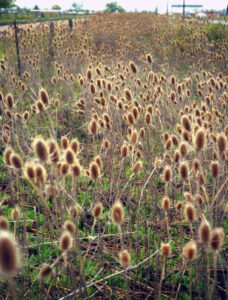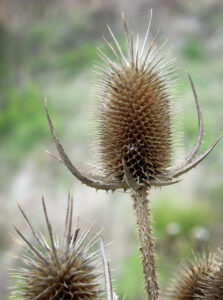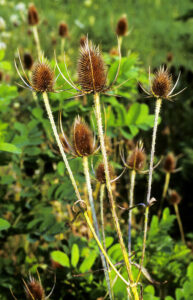
Common teasel in bloom. The flowerheads of teasel species are distinct, unusually large, stiff and sturdy. / Photo Credit: Steve Dewey, Utah State University, Bugwood.org
By Erika Segerson-Mueller, DNR Invasive Plant Program Specialist, Oshkosh Service Center
Erika.SegersonMueller@wisconsin.gov or 715-492-0391
Two species of teasel are present in Wisconsin: common teasel (Dipsacus fullonum) and cut-leaved teasel (Dipsacus lacinatus). Although they are known today as invasive plants, their Latin names speak to a useful history.
The species name of common teasel (fullonum) comes from “to full,” a step in woolen clothmaking that involves using water and agitation. Teasels, native to Europe, were introduced to North America in the 1700s to be used in this manner by textile processors. The stiff and sturdy flower heads of teasel were used to comb the surface of damp cloth to give it a fluffier finish.

An infestation of common teasel on a roadside. Though once useful plants, the teasels have escaped cultivation and are aggressive invasive plants. / Photo Credit: Steve Dewey, Utah State University, Bugwood.org
Today’s Teasel Problem
As technology advanced, different methods of fulling were eventually invented and teasel was no longer in demand. Unfortunately, teasels that were planted on purpose escaped cultivation and began invading natural areas.
Invasive teasels now occupy open areas, prairies, savannas, meadows and other disturbed areas. Cut-leaved teasel has been observed to have rapid range expansion in several midwestern states, meaning it is evolving to be able to grow in even more areas. Although not commonly found in the woods yet, teasel could continue its spread in areas such as logging roads, landings and parks, so control of these species is important.
Teasel is still found in horticultural plantings and along roadsides where the seeds spread easily; each teasel plant can produce as many as 2,000 seeds. Shockingly large populations can be seen on some roadsides in Wisconsin. Like other invasive plants, teasel outcompetes native plants, reduces biodiversity and impacts wildlife forage habitat.

Cut-leaved teasel is expanding its range in the Midwest, growing in more locations than where it was previously found. / Photo Credit: Chris Evans, University of Illinois, Bugwood.org
Teasel can frequently be found in dried floral arrangements or at plant sales. Teasels are regulated species under NR40, Wisconsin’s Invasive Species Rule, and should not be bought, sold or transported.
How To Identify Teasel
The genus of the Latin name also speaks to a unique feature of these plants. Dipsacus is derived from the Greek word dipsa, meaning thirst. The stem leaves of teasel have bases that clasp the stem and form a cup that allows teasel to collect rainwater. Insects frequently drown in these cups, and the nutrients from the insects are eventually absorbed by the plant, making teasel somewhat carnivorous.
In addition to the cup-shaped leaves, teasels have several features that make them quite distinctive.
Both common and cut-leaved teasel grow in a basal rosette (low-lying cluster of leaves growing near the ground) for at least one year. In the second or third year, a prickly, angled flowering stalk forms that can be two to six feet tall.
Teasel has leaves that are large (up to 1 1/2 feet long), oblong and prickly. Both species have dense, egg-shaped heads that are made up of hundreds of tiny flowers clustered together. Stiff, spiny, leaf-like structures called bracts curve up from the base of the flower heads. The bracts are a good characteristic for identifying which teasel you have: the bracts of cut-leaved teasel are shorter than the flower heads, while the bracts of common teasel are longer than the flower heads.

Cut-leaved teasel (pictured) is visually similar to common teasel, so look closely at the bracts (the leaf-like structures that form a cup around the flower heads) to tell the difference. Shorter bracts are present on cut-leaved teasel. / Photo Credit: Chris Evans, University of Illinois, Bugwood.org; right, Ohio State Weed Lab, The Ohio State University, Bugwood.org

Common teasel has bracts (leaf-like structures that form a cup around the flower heads) that are longer than the flower heads themselves. / Photo Credit: Ohio State Weed Lab, The Ohio State University, Bugwood.org
Common teasel usually blooms from June to October with tiny purple flowers; cut-leaved teasel has white flowers that bloom a bit shorter, from July to September. Both species have exhibited the flower color most commonly associated with the opposite species, so identification shouldn’t be judged solely by flowers. Luckily, identifying the species of teasel isn’t very important; both species are invasive and should be removed quickly to prevent their spread.
Teasel is most commonly mistaken for thistle, another group of plants present in Wisconsin that includes both invasive and native species. The flowerheads can be a good identifier in this case, as teasel has oval flowerheads that are unusually large (up to 4 inches long). The flowerheads of thistle are much smaller, usually under an inch in diameter.
Controlling Invasive Teasel
To control small populations, young rosettes can be dug, making sure the deep taproot (up to two feet long and one inch in diameter) is fully removed. Mature plants can be cut at ground level before flowering to prevent later re-sprouting and flowering. Bag and dispose of any stems and immature seed heads to avoid spread.
Herbicide treatment via foliar spray can be very effective. Treat rosettes during the growing season before flowering stems develop and produce seeds. Rosettes also remain green into fall and early winter and may be treated then.
View the University of Wisconsin-Madison Extension publication on teasel control for more information and specific chemical recommendations.
Want to help tease out teasel from Wisconsin? A cut-leaved teasel pull-a-thon is happening at the Kettle Moraine State Forest – Northern Unit in mid-July. Although cut-leaved teasel is well established in some surrounding areas, it has only been seen in a few sites in the Forest, and past efforts show that it can be contained. The Pull-a-Thon event page offers more details and contact information for the event organizer.
